As I type this, the newest member of my flock, Charlie the galah is with his avian vet and I’m not sure that he’s coming home. I’m sitting next to my mobile phone waiting for news. I’ve lost count of how many times I’ve checked to see if my phone is working. I know I charged it but maybe it has gone flat super fast? Nope. It’s working. It’s also too soon for the vet to call. I know that too. I just can’t quite stop myself from checking my phone though.
Charlie hasn’t been here for long, it has only been a few months and pretty regular vet visits during those months working through his multiple issues. He is a bird with problems and that’s what has made things very difficult from the start. Anyone who has dealt with a rescue bird or an elderly bird will know what it is to know that there are so many things in his past that are impacting now.
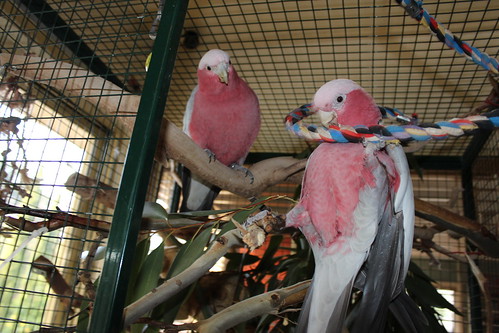
Two of my younger (and healthier) galahs: Nemo and Merlin. These guys have warily accepted Charlie into the flock but understandably are a little more agile than the old man with arthritis!
He came to his previous owner from a rescue. The rescue gave his birth year as 1960 and said that multiple owners had abused him in the past. No details as to what sort of abuse but let’s face it – most rescue birds come with a sob story. It’s a given that he has been through something even if we don’t know what. He had a serious liver issue that his previous owner to me had found and was treating. I knew he’d had giardia from when I birdsat him and treated him last year. He has some feet abnormalities that aren’t unusual in an older bird. I also knew the plucking problem started sometime before 2009. I received a vet history helpfully from his previous owner which included regular blood work from the last 5 years. Things could easily have been worse.
One thing worried me about Charlie more than anything else and that was the way he would straddle his wing, press it into his abdomen and sleep like that. I didn’t know what was causing that? I was questioning arthritis? Or whether it was something to do with the liver problem? I knew from his previous owner that this was a normal pose for him, which meant it wasn’t an urgent problem but it isn’t a normal behaviour for the species. It continued to nag at me and was on my list but he had minor problems like mites and some anxiety issues to get rid of first. In hindsight, I wish this had seemed more urgent and that I’d done an Xray before all of the other tests. I really hate hindsight.
So I was 45mins late home a few days ago. Charlie was bleeding when I got home. The blood was making things look worse than they were. There was a small cut on the plucked bald spot on his abdomen. He’d been chewing on a tree branch and there were small sharp stubby bits – it was possible he’d slipped and scratched his stomach. It was more likely a self-destructive behavior though. This is a bird that anxiously calls after you if you leave the room. 45 mins late… Had he freaked out and chewed himself to bits because of that? He was straddling his wing again as I wondered that. I decided that instead of treating this as a behavioural issue (which really did look like the most likely cause), I’d deal with that gut feeling that something medical that wasn’t showing in his bloods was going on and causing that weird wing straddle.
We went to the vet for an Xray. The vet added more blood tests the list of things to check too. I left him there for the day because an Xray requires an anaesthetic.
I went home and when I went to clean his cage, found I’d missed some vomit that morning. I rang the vet and let them know that he was vomiting. I was now damn glad he was at the vet because the vomit reinforced the idea this was medical, not behavioural.
Not surprisingly, the Xray was abnormal. The liver problem was obvious and chronic. I have another galah here with a serious liver condition. Morgy should have died last year but instead she’s on specialized liver medications and is still going strong. The medications are working for her. Charlie’s liver was worse than Morgy’s and that terrified me because I didn’t believe it was possible to be worse than Morgy and still be breathing? The only positive I could see was that I wasn’t having to wait for weeks for specialized meds to be compounded. They were already in my fridge at home. I thought I had my answer. I thought I knew what came next and what to do. I was wrong.
Charlie came home after that Xray and continued to vomit. The vet adjusted his meds accordingly. I went back and picked up an antibiotic in the hope this would help. It was hoped that the medications would relieve the liver symptoms enough to stop the vomiting. They didn’t.
It was now Saturday afternoon and every avian vet in the state was closed. I could feel the small window of time when he was still strong enough to save was fast disappearing and I was worried. If I couldn’t control the vomiting soon, he was going to deteriorate fast. I was switching what I was doing to emergency first aid. I was adding the equivalent of a bird electrolyte to his water because suddenly keeping him hydrated was more important than anything else. He was bright enough, singing and dancing and didn’t look like he was dying. I knew otherwise though. I was measuring exactly how much he was keeping down and I knew that I was in very real trouble.
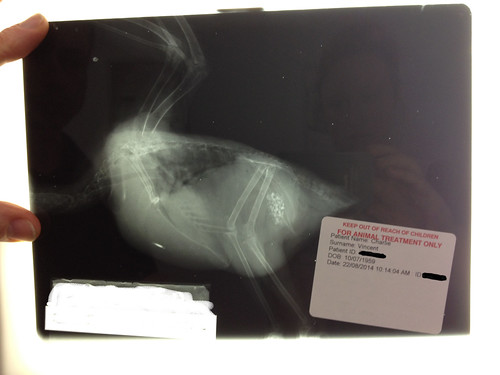
Charlie’s Xray. The liver is so big it has pushed other organs out of place. E.g. The gizzard. (The oval white dotted shape behind his legs). That should be much lower down, more between his legs.
I was consulting with Charlie’s vet via phone. He agreed that I needed to act before he deteriorated but it was after hours and he wasn’t where he could do it himself. He referred me to a 24 hr emergency service because he wanted Charlie hospitalized. I rang them. They didn’t want him. They weren’t comfortable with birds. They’d see him if I pushed it, they said that they didn’t want to though. They told me that if I insisted on coming in they wouldn’t guarantee they’d be able to give him fluids but would charge me hundreds and hundreds of dollars to even look at him without doing so. They advised me to try one of the animal shelters as someone there might know something about birds. I can honestly say it’s a horrifying feeling to realize that your bird’s best hope is YOU. I have my own hospital setup and with a sinking feeling I realised that I needed it.
I still needed help to get some lifesaving fluids into him though and that’s not something a person can do by oneself. I rang my cat/dog vet. They have a 24 hr service for cats and dogs and agreed to help me if my avian vet would talk them through it on the phone while I assisted during the actual procedure.
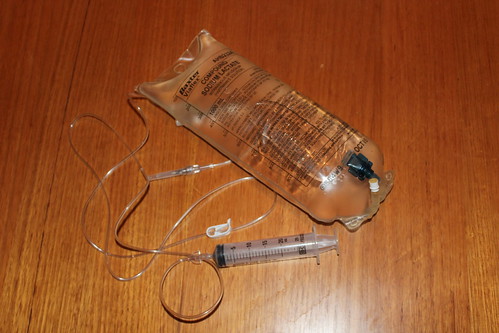
IV Fluids – not something that you’ll find in a normal animal first aid kit but something Australian wildlife rescuers find themselves needing/using regularly. So frustratingly I had everything I needed, except for the vet/physical assistance.
Charlie sang and danced his way through that appointment. I was seriously annoyed with Charlie for doing that. To a vet that isn’t used to seeing birds, this didn’t appear to be a sick bird. It’s no wonder that people don’t notice their bird is sick until it’s too late! Without my avian vet on the phone and me pushing it in person, I think the normal result of this sort of appointment would have been to send the bird home with the advice to keep him warm and see your avian vet for a checkup on Monday.
I was able to assist the vet as he injected fluids and medications and was damn glad of my wildlife rescue training (which is actually way more practical than vet school) because I could point to where the needles needed to go and restrain him correctly. Charlie wasn’t a cooperative patient. I knew that in putting him through this I was damaging his trust with me but I also knew he was dead if I didn’t do it.
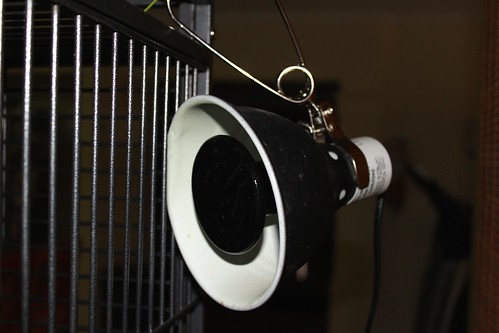
Heat Lamp. If you don’t have one – get one. This should be in the average bird person’s first aid kit. Your bird’s ability to control it’s temperature is the first thing to go when it is sick. A heat lamp can buy you precious time and keep your bird alive through an illness. They’re usually sold as Reptile Lamps. I use a 60W ceramic globe.
By Sunday, Charlie had deteriorated further. There was an avian vet open for the morning (not Charlie’s vet, but still someone I trusted, knew from past experience that he’s great with the added bonus of knowing he is friends with Charlie’s normal avian vet). I took Charlie in. It was incredibly busy. There were a lot of birds needing help but the vet managed to fit us in. Charlie had more fluids, more medications and a crop feed. Charlie managed to keep half of the crop feed down. At this stage, those fluids and crop feed had been life-saving but I knew it still wasn’t enough. I was back at the dog/cat vet only four hours later, repeating what I’d done the night before. This time I got lucky. The vet on duty was one of my avian vet’s recently graduated students. He knew what he was doing.
Having a bird that can’t keep food down? That’s a nightmare. Telling him he’s not allowed to eat in order to give his digestive system a break? Not easy. Having a bird who sits in front of where his food bowl normally is, accusingly chanting “Yummy?” over and over and over? Well it physically hurt me to say no to that.
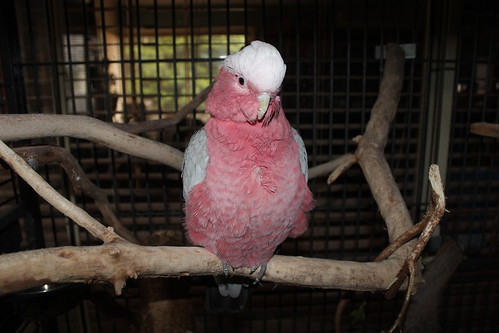
One of my other galahs – Morgy. With a liver that rivals Charlie’s for being a disaster, I count Morgy as a miracle. As her liver condition has come under control, her heart problem has recently shown more clearly on her X-rays. That was diagnosed less than a month ago but she’s doing well now that she’s on heart medications. It also turns out she’s older than I thought – her X-ray has shown she has mild arthritis. When I say it’s a miracle she’s alive and able to maintain a decent quality of life – I mean it.
By now, I knew my goal was to keep him alive and strong enough to go back to his own vet Monday morning. I knew that another Xray was the plan and hopefully if given contrast, it would show more than the one on Friday.
I managed that goal. The phone call I’ve been waiting for has come while I’ve been writing this blogpost. It’s the phone call that would tell me if he’d survived the anaesthetic for that Xray and if I had answers. He’s alive. The Xray gave answers. Not good ones though.

This Xray is from Morgy – not Charlie. It still isn’t “normal”. You can see her gizzard isn’t pushed as far back as Charlie’s. This is what an Xray looks like when contrast is used. The contrast should ideally travel through the digestive system showing any blockages (the bright white stuff above the gizzard is the contrast doing this). Morgy has no blockages.
Charlie’s 2nd Xray has shown that he has some sort of mass growing between his heart and his liver pushing his other organs around. Depending on what that mass is – it may or may not be treatable. The next step is to get him strong and stable enough to cope with surgery. The only good news is that the pain medications he’d had over the weekend had performed an extra function. They’d reduced the size of the mass, by reducing inflammation so that it showed more clearly on the latest Xray, compared to the one taken the week before. It was the mass that was pressing on the stomach causing vomiting. If medications could reduce it’s size – there was suddenly hope that he might recover enough to undergo surgery.
So that’s where I am. He’s stable but still critically ill. It’s a few days later and he’s back at home in my hospital setup. Needless to say he needs fairly constant supervision. His surgery is scheduled for early next week. I’m praying for a miracle. Apparently I’m hoping for a cyst rather than a tumour? Really though, I just don’t want him to suffer and want him to have the retirement with other galahs that he deserves.

Too sick for a cage, Charlie is in my “hospital setup”. He’s at home in a heat box, just like he would be if he was hospitalised at the vet’s. This is not something I would expect the average bird person to have on hand. Considering I have a 65 year old galah with a heart condition, another who is around 30 years old with liver & heart issues and now Charlie… This box is something that is apparently essential for my retirement home for galahs!
What does all this tell me? Well, I can say that bird owners have it tougher than dog and cat owners. Our beloved pets are better at hiding what’s wrong. We have to be able to recognise really early signs of illness. There is also more pressure on us to have a higher level of knowledge to help them through a medical emergency. We also need to have equipment on hand at home, allowing us to use that knowledge effectively. We usually don’t have the luxury of being able to rely on standard out-of-hours vet services to give us the best possible chance of helping our loved ones. Sadly at the present time there is a larger element of “do it yourself” when you’re dealing with a sick bird than is ideal.
I’ve had my share of vet bills lately. I have a large flock. The older birds, or birds that have come from less than ideal backgrounds have ongoing permanent conditions such as arthritis, heart and liver issues. You can draw a line down the middle of my flock. The ones that I’ve had from a young age pass their vet checks problem free, the rest require a lot more work. I’ve had my share of miracles – I’ve got a few birds here that are doing well despite the odds. I only hope Charlie makes it onto that miracle list too. Birds really can break your heart.
Further to all of the above, it’s a week later. Charlie did regain his strength enough to get through the surgery. He has since survived that surgery and come back home to my hospital setup where he is recovering. The mass that was visible on the Xray? It turned out it wasn’t a mass but just more liver. Charlie has the worst liver my vet has ever seen. He’s had a biopsy and I’m waiting for results to find out what exactly the cause is, which will help determine treatment. He isn’t out of danger, his condition is extremely serious and life threatening, but it’s looking like he’s got a good chance of being very similar to my other galah Morgy in that they both seem to defy odds. Apparently I got the miracle I was hoping for. Now all I have to do is work out how to stop a galah from destroying a heat box?



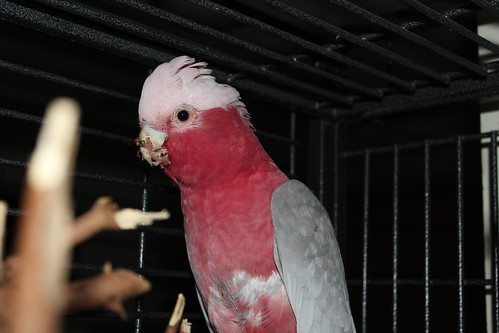
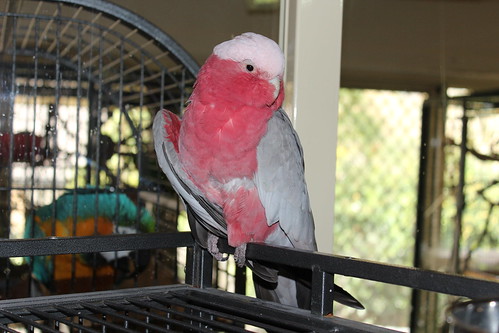
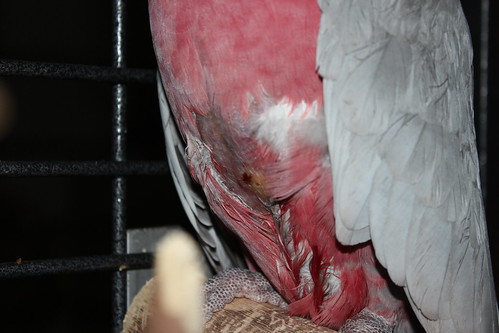
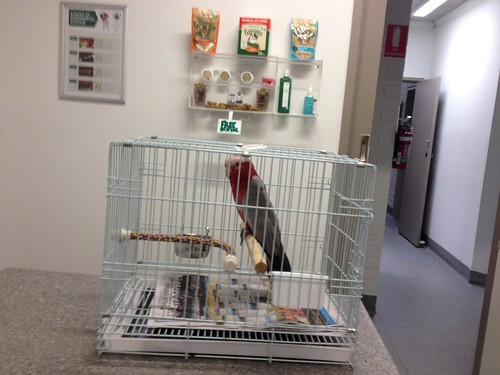


1 comment
What a wonderful job Mel vincent has done helping, caring for & loving these beautiful parrots. Both galahs are very fortunate to have someone that never gave up on them, sadly a lot of vets know very little about birds. All vets should know how to treat all animals, inc rare & unusual pets & wildlife, birds have been a very popular pet for years, just like dogs & cats, so I cannot understand why there is so little veterinary help available for them even in the capital cities in Australia. I had a brilliant avian vet in Melbourne who dearly loved all birds, he was absolutely brilliant, he knew everything there was to know about birds & was so caring & gentle with them, sadly he retired & there were only 2 other avian vets i & other bird owners knew of in melb. Vets need to learn a lot more & take a lot more interest in birds in general, they are every bit as precious as all other animals. I lost my first ever beautiful eclectus parrot. He wasn’t even 3 years old when he died. I took him to my avian vet because his beak didn’t grow much & never coloured up to orange & he had some little yellow feathers coming through, there were no other symptoms, he ate well, played heaps was a very good talker! Had lots of energy & was very cuddly & interactive, liver problems were suspected, 4 lots of blood & other tests failed to pick anything up. One morning we woke up to blood on him & all over his cage i thought maybe he had caught a feather on one of his toys & pulled it too hard. We rushed him to the avian vet he was a bit quiet but otherwise ok, chattering away like always! The last lot of tests 12 days before this were all normal. He was hospitalised the vet did everything he could to try & save him bet he went downhill fast & died5 hrs later. I wanted an autopsy done so we’d know what had happened to our beautiful baby. It showed he was born with a liver problem, the vet said its a miracle he lived as long as he did. All animal medical people need to update their knowledge of birds & their illnesses & injuries to help care for these beautiful animals by doing so they could make a big difference. Its heart breaking to lose both fur & feather babies
Leave a comment